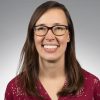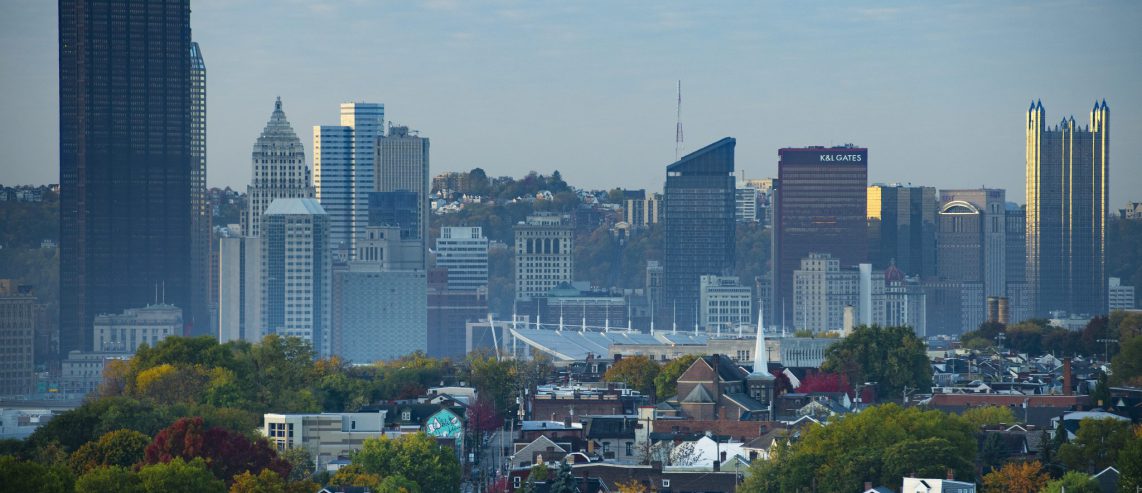Sharon Mackall feels a sense of pride when she visits Second Avenue Commons.
The facility helps people from Pittsburgh and western Pennsylvania who are experiencing homelessness or have unstable living situations. It includes a shelter, medical services — including a primary care clinic that UPMC operates — and other resources for people experiencing homelessness and unstable housing.
Since opening in late 2022 at 700 Second Ave. in Pittsburgh, the facility has become what Mackall describes as a “hub of activity.”
Within the first 48 hours, all of the shelter beds were filled. So were many of the overflow beds and single-room occupancy (SRO) housing units.
“It opened with a bang,” says Mackall, director, Clinical Care Coordination, Discharge Planning, and Capacity, UPMC Mercy. “It wasn’t a trickle in of individuals. It was a flood, which is great.
“You see the outside business around Second Avenue Commons, but if you go inside, it’s actually a hub of activity. There’s people in the drop-in center on the computers, making a sandwich, getting a drink, chatting with people, taking advantage of the services that are there for them. So, it’s great to see that it was used so quickly and so fully. I love going down there.”
UPMC was an initial investor in Second Avenue Commons and helped to shape its development. A team comprised of representatives from local corporations, government entities, and service organizations helped to make the facility possible.
Among its many resources, Second Avenue Commons includes:
- Shelter housing with 95 beds, plus additional winter housing from Nov. 15 to March 15.
- 43 SRO apartment units.
- The UPMC Second Avenue Commons Health Center, a medical and behavioral health clinic.
- A “daytime engagement center,” featuring grab-and-go lunches, snacks, computer access, laundry services, and connection to housing and other important resources.
- A professional kitchen, with job training opportunities.
“Second Avenue Commons is a unique service to the nation, having all of these services under one roof,” Mackall says. “To see it grow is great.”
Never Miss a Beat!
Subscribe to Our HealthBeat Newsletter!
Thank you for subscribing!
You can now select the specific newsletters you'd like to receive.
You are already subscribed.
Subscribe to more newsletters in our email preference center.
Sorry, an error occurred. Please try again later.
Get Healthy Tips Sent to Your Phone!
‘Help as Many People as You Can’
The idea for Second Avenue Commons originated in 2019 at a meeting between leaders from UPMC and two other corporations. They decided to collaborate on a project that would help people in western Pennsylvania who were experiencing homelessness.
Each of the three primary corporations committed to providing at least $5 million to funding the building of the facility or providing services once it opened.
“The goal that we were presented with initially was, ‘Help as many people as you can,'” says Mackall, who was involved in the development from the beginning.
Other businesses, government entities, and service organizations joined in the development of the project, contributing money and ideas.
“Throughout the development of the project, there was a lot more assistance that came,” Mackall says.
Early in the process, about 15 people from the planning team, as well as the facility’s design team, traveled to Portland, Ore. Portland has one of the highest homeless populations per capita in the U.S. Leaders there traditionally invest significant resources to provide support for the homeless population.
“We went out there to learn what works and what doesn’t,” Mackall says. “So we spent three days touring homeless services, shelters, walk-in clinics, outpatient services, housing day shelters, overnight shelters. We interviewed the residents as well as the staff to say, “If you could build your dream facility, what would it look like?’ And we applied those principles to the development of Second Avenue Commons.”
The team learned three crucial factors that were especially important to people experiencing homelessness, Mackall says — people, possessions, and pets.
Many shelters are one-gender only, which deters people who are in a relationship. Having a safe place to secure their possessions is also crucial. And it was important for people experiencing homelessness who have pets to be able to bring them into the shelter.
The Second Avenue Commons team made sure to address all of those needs. Second Avenue Commons has coed housing, meaning people in relationships are not turned away. The facility has secure locations where people can safely store their precious possessions, as well as a room to sterilize those possessions for lice, bedbugs, and other issues. And Second Avenue Commons allows people to bring in their dogs and cats.
Second Avenue Commons is also a low-barrier shelter, with limited requirements for entry. Where some facilities might not accept people who have an active substance abuse disorder, Second Avenue Commons does. The focus is on reducing harm and helping individuals who might have substance use disorders, mental health conditions, or other problems.
“(It has) a therapeutic environment, staff that know how to practice harm reduction, as well as a low barrier,” Mackall says. “If an individual’s still in active addiction, they are not excluded from the shelter.”
After the Portland trip, the planning committee continued to meet frequently. Second Avenue Commons officially opened in November 2022.
‘Health Care the Way That It Should Be’
UPMC committed $6.5 million to Second Avenue Commons for in-kind services to provide medical and behavioral care with the UPMC Second Avenue Commons Health Clinic. The money went toward establishing the clinic and operational costs like stocking necessary medications.
Like Second Avenue Commons itself, the health clinic is low-barrier. People don’t need insurance to get care. Nor do they need an appointment — they can drop in.
“We try to eliminate any barriers that people may have to seeking medical care,” says Anita Leon-Jhong, MD, the clinic’s medical director.
“Those include things like insurance and scheduling appointments, but also having prior negative experiences or prior traumatic experiences with the health care system. We really try to create a really welcoming experience for people. We have our doors wide open.”
Mackall approached Dr. Leon-Jhong during the planning process to see if she would be interested in becoming medical director. A primary care doctor, Dr. Leon-Jhong had experience working with people with medical and psychosocial conditions, people with substance use disorders, and people experiencing homelessness.
“I was over the moon, basically, to hear about it,” Dr. Leon-Jhong says.
“We feel like we get to practice health care the way that it should be, and we feel really lucky that we have gotten to design a clinic that is exactly how we feel health care should be, where people can get the service that they need in that moment — regardless of all these other things like insurance. So, it’s wonderful.”
The clinic is open Monday to Friday from 9 a.m. to 5 p.m. It operates in a similar way to any primary care clinic, treating many different health issues for people experiencing homelessness.
Some of the most common include foot care, skin care, wound care, respiratory and other infections, and chronic conditions like diabetes. A doctor who specializes in street medicine is there for four hours each day treating patients, and a nurse is there all day treating patients.
The clinic also includes a behavioral health specialist who can treat people with mental health or substance abuse conditions. Dr. Leong-Jhong says many people have visited to get reconnected to psychiatric care and their medications.
Anyone can come to the clinic — shelter and SRO residents, along with people who are using the drop-in engagement center. The clinic sees about 30 to 40 people a day, including scheduled doctor and nurse appointments and drop-ins who are looking for services like headache medication.
Mackall says the planning team met with the nurse manager of an in-shelter clinic during the early Portland trip. His recommendations included extended hours, an in-clinic physician, and the ability for nonresidents to receive care. UPMC took those recommendations into account when establishing the Second Avenue Commons clinic.
“We wanted to be inclusive of people who were in the shelter as well as individuals who just needed help but didn’t have the means to get done what they needed to get done,” Mackall says.
Many times, people who are experiencing homelessness or people who are unstably housed have limited options for health care. Often, they turn to the emergency department for care. The clinic provides another option for people in need.
“The value of this clinic is that we’re able to treat people when they need it, where they need it,” Dr. Leon-Jhong says. “They don’t need to go somewhere else to try to seek medical care. Almost any condition that they could have, we’re able to treat right here in the most appropriate setting, which is a primary care setting.
“Being able to provide that very appropriate care in the moment, in a very compassionate way, is just really rewarding. Our staff just feels so grateful to be part of this project and really provide the care that people deserve in a way that we really feel good about.”
In addition to treating acute conditions, the Second Avenue Commons clinic staff can help people get connected for appropriate follow-up care. For example, if someone has a heart condition that requires follow-up, the staff can help that person make an appointment for follow-up care with a specialist.
“One of the main goals of the clinic is getting people connected and reconnected to the services that they need,” Dr. Leon-Jhong says. “Because people are just in the state of disconnection due to being homeless and a lot of different barriers that are going on in their lives.”
Dr. Leon-Jhong says she wondered whether some people might be unsure about using the clinic. Many people experiencing homelessness have past negative experiences with health care.
That hasn’t been a problem at the Second Avenue Commons clinic. Usage of the clinic has grown through word of mouth. Many of the clinic’s previous patients have become ambassadors.
“Really, immediately, people were very interested in accessing care,” Dr. Leon-Jhong says. “So, we felt really good that the model we had built was very well-received by people.”
As the clinic continues to operate, Dr. Leon-Jhong hopes to increase the amount of specialized care. Through a recent partnership, the clinic can now provide eyeglasses to people who need them. She says they are working on providing additional specialties like ophthalmology and dermatology.
For more information on the UPMC Second Avenue Commons Health Center, visit our website.
“I think it’s a blessing for the Pittsburgh area,” Mackall says. “Not only for the individuals experiencing homelessness, but for the health care providers who struggle with not having a service to refer patients to. I think it’s really great.”
Editor's Note: This article was originally published on , and was last reviewed on .
About UPMC
Headquartered in Pittsburgh, UPMC is a world-renowned health care provider and insurer. We operate 40 hospitals and 800 doctors’ offices and outpatient centers, with locations throughout Pennsylvania, Maryland, New York, West Virginia, and internationally. We employ 4,900 physicians, and we are leaders in clinical care, groundbreaking research, and treatment breakthroughs. U.S. News & World Report consistently ranks UPMC Presbyterian Shadyside as one of the nation’s best hospitals in many specialties and ranks UPMC Children’s Hospital of Pittsburgh on its Honor Roll of America’s Best Children’s Hospitals. We are dedicated to providing Life Changing Medicine to our communities.

